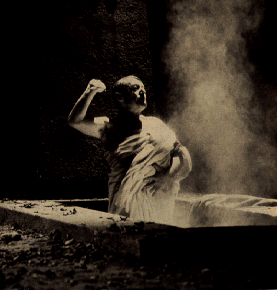 Susan Sontag has been one of the most perceptive critics to engage Hans
Jürgen Syberberg's Hitler, A Film from Germany
, which was released in the United States under the title
Our Hitler by Francis Ford Coppola. The film itself, made in twenty
days of shooting after four years of preparation on a budget of $500,000,
caused an anormous controversy when it was released in 1979, and continues to
call for responses, both positive and negative, in critical circles today. In
the United States, it appears as there are no distribution rights. The fil is,
however, available for rent through West Glen Films in New York City.
Susan Sontag has been one of the most perceptive critics to engage Hans
Jürgen Syberberg's Hitler, A Film from Germany
, which was released in the United States under the title
Our Hitler by Francis Ford Coppola. The film itself, made in twenty
days of shooting after four years of preparation on a budget of $500,000,
caused an anormous controversy when it was released in 1979, and continues to
call for responses, both positive and negative, in critical circles today. In
the United States, it appears as there are no distribution rights. The fil is,
however, available for rent through West Glen Films in New York City.
Sontag begins her analysis of Syberberg's film with the claim that the Romantic desire for the "great work" of art, thought by many to be impossible, returns in Syberberg's film in a powerful rereading that takes into account its own anachronism. Modernism, according to Sontag, has been stripped of its heroic nature as an adversary sensibility.(138) The untimely nature of Syberberg's undertaking is brought to the fore: it purports to be, once again, a "great work of art," one that has incorporated a self-reflection concerning what it means to construct such a "great work" in the late 20th century, and the complicity of this art-form with the grandiose staging of Nazi Germany.
Syberberg's two themes are film and Hitler, the art medium of the twentieth century and the subject of the twentieth century. One might include here all of the permutations of these two terms: Hitler as film, Hitler in film, film as Hitler's privileged medium, and our own, contemporary construction of Hitler as one that is, ultimately, cinematic in the sense that Hitler functions as a "screen" for many of the internal projection machanisms of modern mass culture, Germany in particular. These two themes in their entwinement are articulated and interrogated on a grand, even "mythic" scale, enacted theatrically on a stage, combining and mixing different modes, genres, media: the puppet show, the fairy tale, circus, morality play, philosophical dialogue, and, of course, film itself.
Syberberg dispenses with all realistic representation. According to Sontag, to simulate atrocity requires the passification of the audience, something that Syberberg struggles against. It also reinforces stereotypes and simplistic generalizations, and confirms our distance from the event and the practice of Nazism. For Syberberg, there is a morally appropriate or apt way to confront Nazi Germany and the Holocaust: one must dispense with realism and realistic conventionality. Simulation of the Genocide as fiction transforms realistic representation into a form of pornography.
In contrast to the documentary narrative of films such as Alain Resnais' Stranded Objects, specifically the chapter "Allegories of Grieving." Another extremely useful reading is done by Anton Kaes, "Holocaust and the End of History," Saul Friedländer, ed.,Probing the Limits of Representation (Cambridge: Harvard University Press, 1992), 206-222.
Syberberg's film is, according to his own statements about the making of the film, a personal act of Trauerarbeit or a labor of mourning. For more on this concept and how it has been effectively employed in work on the Holocaust, see Psychoanalysis, and the sections on such critics as Santner and the basis of this psychoanalytic reading strategy in Freud. Also crucial with regard to the Trauerarbeit and Postwar Germany is the decisive study by Alexander and Margarete Mitscherlich The Inability to Mourn published in 1967.